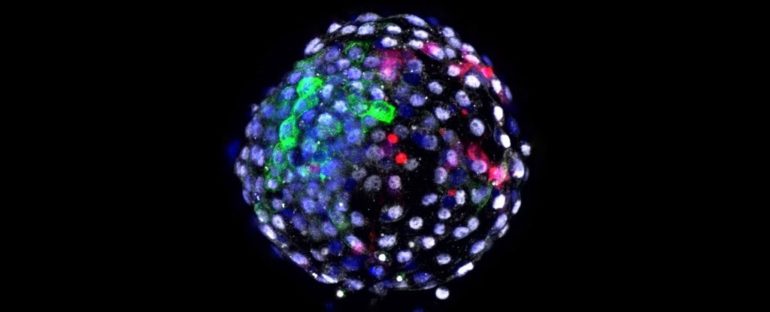If you could cross a monkey with a human, what might that creature tell us? We are beginning to find out.
In a pioneering and controversial experiment, scientists successfully created just such a hybrid: a chimeric combination of monkey and human cells, existing together in a living embryo that otherwise would never have been conceived by nature alone.
Ethically fraught science? Yes. Mad science? No.
While research into human-animal hybrids has a long and questionable history, in recent years researchers have pursued chimeric organisms to probe questions of biology that stand to offer significant gains in fields such as regenerative medicine.
 A chimera human-monkey blastocyst. (Weizhi Ji/Kunming University of Science and Technology)
A chimera human-monkey blastocyst. (Weizhi Ji/Kunming University of Science and Technology)
For example, if we were somehow able to master growing human organs in pig tissue, it might go a long way to solving the huge organ shortage that costs human lives everyday.
To that end, a team led by gene expression expert Juan Carlos Izpisua Belmonte from the Salk Institute in California made headlines in 2017, creating the first pig-human hybrid embryo, with a view to one day being able to produce transplantable human organs from the animals.
As it happened, much like in similar experiments with sheep-human hybrids, the amount of successfully integrated human cells was very low, suggesting certain incompatibilities between the pig and human biology at a molecular level.
To try again with something a little closer to home, Izpisua Belmonte – together with a team led by primate reproduction biologist Weizhi Ji from the Kunming University of Science and Technology in China – conducted new experiments with macaque monkey (Macaca fascicularis) embryos, injecting them with human stem cells, to gauge how these distant-but-related animal cells might coexist as one.
In each of the monkey blastocysts studied, 25 human extended pluripotent stem cells (hEPSCs) were injected – a form of stem cell with the ability to contribute to both the embryo and the surrounding tissues that will support its development.
Using fluorescent tagging, the researchers were able to see that the human cells had successfully integrated in 132 of the macaque embryos, and after 10 days, 103 of the chimeric embryos were still alive and developing.
However, the survival rate began to diminish, and by day 19, only three chimeras were still alive, at which point all the hybrid embryos were terminated in line with the experimental parameters. The results overall showed a more successful integration than the pig-human chimera of 2017.
In addition, genetic sequencing of the blastocyst cells via a technique called transcriptome analysis revealed new clues about cellular communication inside the hybrids, which could greatly expand our understanding of how to make part-human chimeras succeed.
“From these analyses, several communication pathways that were either novel or strengthened in the chimeric cells were identified,” Izpisua Belmonte says.
“Understanding which pathways are involved in chimeric cell communication will allow us to possibly enhance this communication and increase the efficiency of chimerism in a host species that’s more evolutionarily distant to humans.”
Be that as it may, this kind of research makes many in the scientific community uneasy, meddling with both human life and concepts of animal welfare in ways that some consider either unethical or uncomfortably borderline.
While Izpisua Belmonte and his team emphasize that the research was conducted with the “utmost attention to ethical considerations and by coordinating closely with regulatory agencies”, some have suggested these particular experiments may have been conducted in China to get around legal issues that might have prevented the work elsewhere.
“We are doing the experiments with monkeys in China because, in principle, they cannot be done here because of lack of infrastructure,” one of the study authors, developmental biologist Estrella Núñez Delicado from Spain’s Universidad Catolica San Antonio de Murcia told Spanish newspaper El Pais in 2019 when news of the study first broke.
In this case, all the embryos were destroyed within 20 days of their creation, but questions swirl around what would happen if such embryonic organisms were let to live longer, potentially developing the rudiments of a nervous system, or even aspects of consciousness or emotions.
Philosophical questions are not new in science, but such is the pace of development in research like this, that each successive advancement throws up fresh uncertainties and scientific possibilities that often haven’t been considered before.
“New research often pushes up against the limits of existing thinking about ethics; this research is no exception,” ethicists Henry T. Greely and Nita A. Farahan explain in a commentary published alongside the study.
“While human/non-human chimeras involving living or fetal animals have been discussed for nearly 20 years, little to no ethical discussion has focused on putting human cells into non-human blastocysts (let alone non-human primate blastocysts).”
The findings are reported in Cell.



